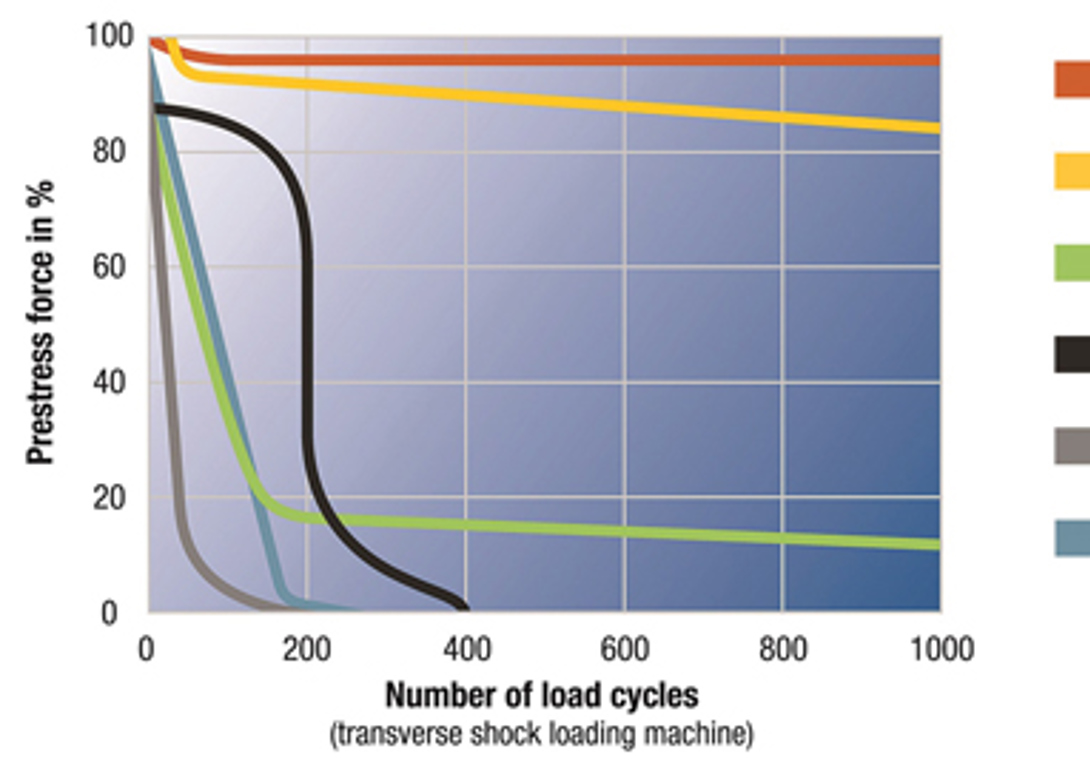
Many applications require a dismountable, yet durable, screw joint but often this freedom to dismantle comes at a price because the chosen securing method has limitations, argues Henkel.
Why assemblies fail
Threaded assemblies generally fail because of a loss of bolt tension, the main causes of which are relaxation and self-loosening. Relaxation results in a change in bolt tension, which leads to reduced clamping forces. This effect is mostly triggered by settling – pressure-induced smoothing of the surface roughness – or creeping, the time-dependent yielding of substrates when loads exceed the compressive strength of the material; clamping gaskets are a typical example.
If the elastic capacity of the assembly is inadequate - for example, if bolts are too stiff or the wrong length to diameter ratio is selected - there can be no compensation for loss of bolt tension.
Self-loosening is caused by any type of dynamic load, such as vibration or changes in temperature, insufficient clamp load and poorly fitting parts, allowing relative movements to increase the risk of self-loosening. These load changes lead to short-term frictionless situations where the bolt unwinds from the nut. The sum of these very small movements ultimately results in the loosening of the threaded assembly.
While relaxation can only be reduced by changes in parts design - such as the length to diameter ratio - or the use of elements, self-loosening can only be avoided by using appropriate thread locking devices.
Thread locking options
Essentially these fall into two camps - mechanical methods and adhesives. There are benefits from using mechanical devices but due to gaps between the threads, their ability to withstand vibrational loosening is compromised.
Thread locking adhesives resist vibrational loosening as they fill all the voids between the nut and bolt. This can be demonstrated by comparing a range of joints, secured in different ways, in accelerated vibration tests on a transverse shock machine. Initially the time taken to loosen a nominal ‘naked’ nut and bolt, tightened to a typical 80% proof load, was determined. From a bolt tension of 30kN, it came loose after just 15 seconds.

As you can see from the graph, a spring washer fared no better, while a nylon ring nut lasted around 25 seconds. A distorted locknut achieved a little longer, although most of the bolt tension quickly disappeared. However, the joint secured with thread locking adhesive did not fail at all and exhibited no loss of bolt tension. Quite simply, this is because the joint is completely filled with adhesive, presenting no opportunity for loosening.
Better and better
All thread locking adhesives under the LOCTITE® brand are anaerobic, which means they only cure in the absence of air. Indeed, it was the very problem of vibration that led Dr Vernon Krieble – the pioneer of LOCTITE® adhesives – to develop anaerobic adhesives. This technology enables the adhesive, when applied to a bolt, to stay liquid almost indefinitely until the nut is applied. With no air in the contact areas, the adhesive soon solidifies to a tough thermoset plastic.
Although this is a relatively mature technology, advancements continue to be made. There is now a huge range available offering differences in viscosity, strength, temperature resistance, chemical resistance, oil tolerance, cure speed and hardness/flexibility. Products are now also rated for higher temperature use and are more tolerant of surface contaminants.
Continuous development of product chemistry is especially important in the light of EU Regulations on classifications, labelling and packaging of chemicals implemented in stages since 2009.
The LOCTITE® Health and Safety range is a good case in point in this regard. When these products were introduced, their chemical components required no hazard labelling but that would not be the case today. Continuous development, however, has seen their formulation change in line with these new regulations and users can therefore be assured they are adopting the best practice in terms of workplace safety.
In summary, thread locking adhesives not only resist vibration but also protect against shock and thermal cycling, seal against corrosion and prevent galling. In addition, the joints provide better clamp retention than mechanical clamping devices and offer straightforward disassembly using correctly specified tools.

Will joined Fastener + Fixing Magazine in 2007 and over the last 12 years has experienced every facet of the fastener sector – interviewing key figures within the industry and visiting leading companies and exhibitions around the globe. Will manages the content strategy across all platforms and is the guardian for the high editorial standards that the brand is renowned.





